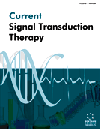- Home
- A-Z Publications
- Current Signal Transduction Therapy
- Previous Issues
- Volume 3, Issue 1, 2008
Current Signal Transduction Therapy - Volume 3, Issue 1, 2008
Volume 3, Issue 1, 2008
-
-
Regulation of TGF-β Signaling by SMADs and its Roles in Tissue Fibrosis
More LessAuthors: Hirotaka Fukasawa, Tatsuo Yamamoto, Masatoshi Kitagawa and Akira HishidaTransforming growth factor-β (TGF-β) is a profibrotic cytokine involved in the accumulation of extracellular matrix proteins and progression of various fibrotic diseases. TGF-β signaling is transmitted predominantly through cell surface serine/threonine kinase receptors to intracellular mediators known as Smads. The inhibitory Smad7 represses TGF-β signaling by interacting with activated TGFβ receptors, and downreg Read More
-
-
-
Estrogen Receptor-Positive and Estrogen Receptor-Negative Human Breast Cancer Cells: Regulation of Expression of Cancer-Related Genes by Estradiol and Tamoxifen
More LessAuthors: Ven Murthy, Xia Yuan and Guojin LiuBreast cancer is one of the most prevalent forms of carcinomas among women world-wide. The oncogenes, tumor suppressor genes and antioxidant enzyme genes are cancer-related genes which play an important role in the initiation, metastasis and malignancy of many cancers, including breast cancer. Estrogen which is a key steroid hormone in the regulation and differentiation of the normal breast also appears Read More
-
-
-
Role of Platelet Signaling in Thrombus Stabilization: Potential Therapeutic Implications
More LessAuthors: Anne Angelillo-Scherrer, Francois Saller and Marc SchapiraPlatelets initiate arrest of bleeding at sites of vascular injury but also trigger inopportune arterial thrombosis, which causes heart attack and stroke. After formation of a single platelet monolayer at the site of injury, additional platelets are recruited into the growing hemostatic plug. Without further stabilization, the platelet plug disaggregates. Its stabilization is ensured by perpetuation of platelet activation. Drugs designed to Read More
-
-
-
Signal Transduction and Photodynamic Therapy
More LessPhotodynamic therapy (PDT), in which stained cells are damaged by light in the presence of oxygen, is now widely used for tumor destruction. Photogenerated singlet oxygen and reactive oxygen species cause oxidative stress and cell death. The potential ROS sensors and following intracellular processes leading to cell death are considered. The cell death mode (necrosis or apoptosis) is shown to be controlled not on Read More
-
Volumes & issues
-
Volume 20 (2025)
-
Volume 19 (2024)
-
Volume 18 (2023)
-
Volume 17 (2022)
-
Volume 16 (2021)
-
Volume 15 (2020)
-
Volume 14 (2019)
-
Volume 13 (2018)
-
Volume 12 (2017)
-
Volume 11 (2016)
-
Volume 10 (2015)
-
Volume 9 (2014)
-
Volume 8 (2013)
-
Volume 7 (2012)
-
Volume 6 (2011)
-
Volume 5 (2010)
-
Volume 4 (2009)
-
Volume 3 (2008)
-
Volume 2 (2007)
-
Volume 1 (2006)
Most Read This Month
Article
content/journals/cst
Journal
10
5
false
en


